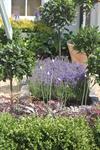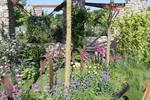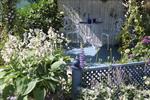
ACS student comment: "Great course, tutor was really good with explaining and marking. [She] gave me new ideas for my garden and hints for it too. Learning so many new things about growing different vegetables, how to grow them and what to do. All about soils and garden plots." Kathryn Crossfield, Australia - Home Vegetable Growing course.
This course contains hundreds of pages of notes, hundreds of photos and illustrations, and (for the online & CD version) large numbers of automated self assessment tests. Become the gardening expert of your family with this comprehensive home gardening course. There are eight units each comprising 2 or 3 lessons, with each lesson involving both reading and practical work. This is a "blue ribbon" course for home gardeners who want the best.
CONTENT
There are 8 units involved in this course. Each unit is made up of 2 or 3 lessons.
The eight units are as follows:‑
1. Basic Plant Identification & Culture
Plant names, planting, transplanting, tools & equipment.
2. Soils & Nutrition
Soil structure, nutrition, composting, soil building, drainage, fertilizers.
3. Pests & Weeds
Identifying problems, sprays, biological control, weed identification & control.
4. Landscaping
How to design a garden, rockeries, native gardens, traditional (European style) home gardens.
5. Propagation
Propagating materials, seed, cuttings.
6. Lawns: Turf varieties, laying a lawn, lawn care.
7. Indoor Gardening
Hardy indoor plants, container growing.
8. The Kitchen Garden
Vegetable gardening, fruit trees, herbs.
 SECRETS OF GARDENING
SECRETS OF GARDENING
There's a system to gardening, and learning to garden well is all about understanding that system. Plants are classified into families, for instance. It can be daunting to learn how to identify hundreds of thousands of plants, but if you can learn the families (there are a lot less families), that's a lot easier. Once you know, for example, how to determine that a plant belongs to the Mint (Lamiaceae) family; you can place any appropriate plant you find into that family. If you then know that mint family plants like a certain type of soil, are propagated a certain way and are susceptible to certain diseases -you can immediately know how to grow the plant you have identified as a mint family plant. Not only that; but if you know the family something belongs to, you only need to consider plants in that family when trying to determine exactly what the species is.
WHAT WILL YOU DO IN THIS COURSE?
Here is just some of what you will do:
- Read notes written and supplied by staff of this school
- Watch instructional video
- Test and name different soils
- Mix inexpensive potting mixes
- Make compost and explain how you made it.
- Learn how to identify plants effectively.
- Explain step by step how you would go about planting shrubs in your own locality.
- Explain how to transplant and transport plants from one property to another.
- Determine the tools required to do gardening for a property, using a limited supply of money.
- Explain characteristics of soil, including: Soil Structure, pH and Nutrient Deficiency
- Describe how to fertilize a lawn
- Explain how to improve drainage in a soil that is too wet for plants to do well in.
- Explain how you would improve a specified soil
- Identify a nutrient deficiency
- Observe and identify different categories of pest and disease problems in growing plants.
- Compile a weed collection with pressings or illustrations of different weeds
- Compile a plant collection with pressings or illustrations of different weeds
- Describe how environmental problems affect plants
- Recommend ways of controlling different types of problems in plants, using both natural and chemical.
- Observe and evaluate different types of gardens.
- Survey a garden in order to prepare a garden design.
- Apply a systematic procedure to landscape design, in order to produce a concept plan for a garden.
- Explain mistakes have you observe in the design and construction of different rockeries
- Build a simple cold frame and us it to propagate plants.
- Prepare propagating mix which would be suitable for striking most types of cuttings.
- Propagate different plants from cuttings.
- Prepare a plan for sowing annual flower seedlings over a 12 month period.
- Evaluate and explain a lawn seed mix from the packaging of that mix
- Observe different lawns and recommend their treatment
- Explain how to establish a lawn
- Observe and evaluate the condition of different indoor plants.
- Recommend the treatment of different indoor plants.
- Prepare lists of indoor plants for different applications.
- Find an indoor plant which needs potting up & pot it up.
- Plant a vegetable patch.
- List fruit, nuts & berries most suited for growing in your locality
- Observe the way in which herbs are used commercially (eg. in medicine, cooking etc)
- Explain why crop rotation is used in growing vegetables?
ADVICE FROM OUR GARDENING TUTORS ON GROWING CLIMBERS
 How can I use climbers in my garden?
How can I use climbers in my garden?
The most obvious use for climbers is to hide ugly views such as utility areas in the garden, or to create privacy from your neighbours or from the road. Climbers can be used to keep people, children and animals in (or out) of your garden or as windbreaks and noise barriers - although the latter will be minimal. Proving shade is another great use for climbers – you can create wonderful ambience in your outdoor living area with a pergola covered in a fruiting grapevine.
Climbers can also define areas of your garden - separating one space of the garden from another into ‘garden rooms’. Breaking a garden up into a lot of small areas can create both interest, and make a garden seem a lot bigger than it really is. This is because a garden which can’t be seen all at once will always seem bigger than an open area - which you can take in with one glance.
How do I grow them?
Depending on the type of climber you want to grow and your garden, you may need to provide it with some growing support. First though it is useful to understand how the climber you want to grow, actually climbs - some need help!
Climbers are usually one of three types: some like scrambling over other plants, building on their own stems for support and gradually growing higher and higher. Some like sweet peas or grape-vines are tendril bearers; the little tendrils wind themselves around anything and to encourage upward growth, a wire trellis is a great support for them. The third type is creepers which often form aerial support roots on the stem, sometimes these types also have small suction cups or sticky ends enabling them to stick firmly onto a flat support or wall; many climbers like ivies and climbing figs will cling to a wall, post, or anything else they touch.
What sort of materials do I need?
You can use materials such as trellis, wire mesh, single wires or nylon strings, it is best to avoid jute, as it will rot within a season and then you would need to keep retying the supports.
Supports can be readily attached to a fence or wall or possibly the uprights or roof of a pergola, arbor or archway, or between two posts. Alternatively you may like to buy or build a purpose-made frame.
Another tip for support that could work in your situation is to allow the climber to climb over rocks, tree stumps or logs; pelargoniums or geraniums are great plants for this purpose. You could also encourage climbers to grow through other plants, thereby extending the flowering season, or to add interest to an otherwise uninteresting plant - for example, clematis through a rose or a rose up a tree. Climbers that work well for this purpose are those that don’t attach themselves readily to a support (i.e. without sticky or twining tendrils).
 What are you looking for in a climber?
What are you looking for in a climber?
Do you want a fast grower, a slow grower? Some climbers grow fast, others slow. Such as Chinese gooseberries and grape vines will live for decades, others such as nasturtiums, sweet peas and beans are annuals and die at the end of each year. Passionfruit have a medium longevity of around 3 years. Fast growers will provide shade or a screen quickly but also usually need more pruning and more often.
Does it need to be evergreen or deciduous? Deciduous climbers such as a wisteria, grapes or roses are often used over a pergola - they will let in the winter sun, but exclude it in summer providing shade. For year round shade, popular plants are some of the Kennedia (native ornamental peas), evergreen jasmines, and evergreen clematis.
Would you like an edible climbing screen of passionfruit or grapes? There are lots of climbing edible plants to choose from including Chinese gooseberry (kiwifruit), climbing beans, peas, choko, nasturtiums (flowers, seeds and leaves are all edible) even climbing tomatoes and climbing spinach (Malabar or Ceylon spinach)! Most edible plants such as these lower in late spring and summer.
Perhaps you would like flowers of special themed colours, flowers for a particular time of the year, flowers for most of the year, just a foliage screen, maybe a perfumed climber or one for a tiny terrace or unit? There are hundreds of different climbers to choose from to suit any position and landscape need and for a wide range of soil types and climates.
ENROL AND START YOUR JOURNEY TODAY